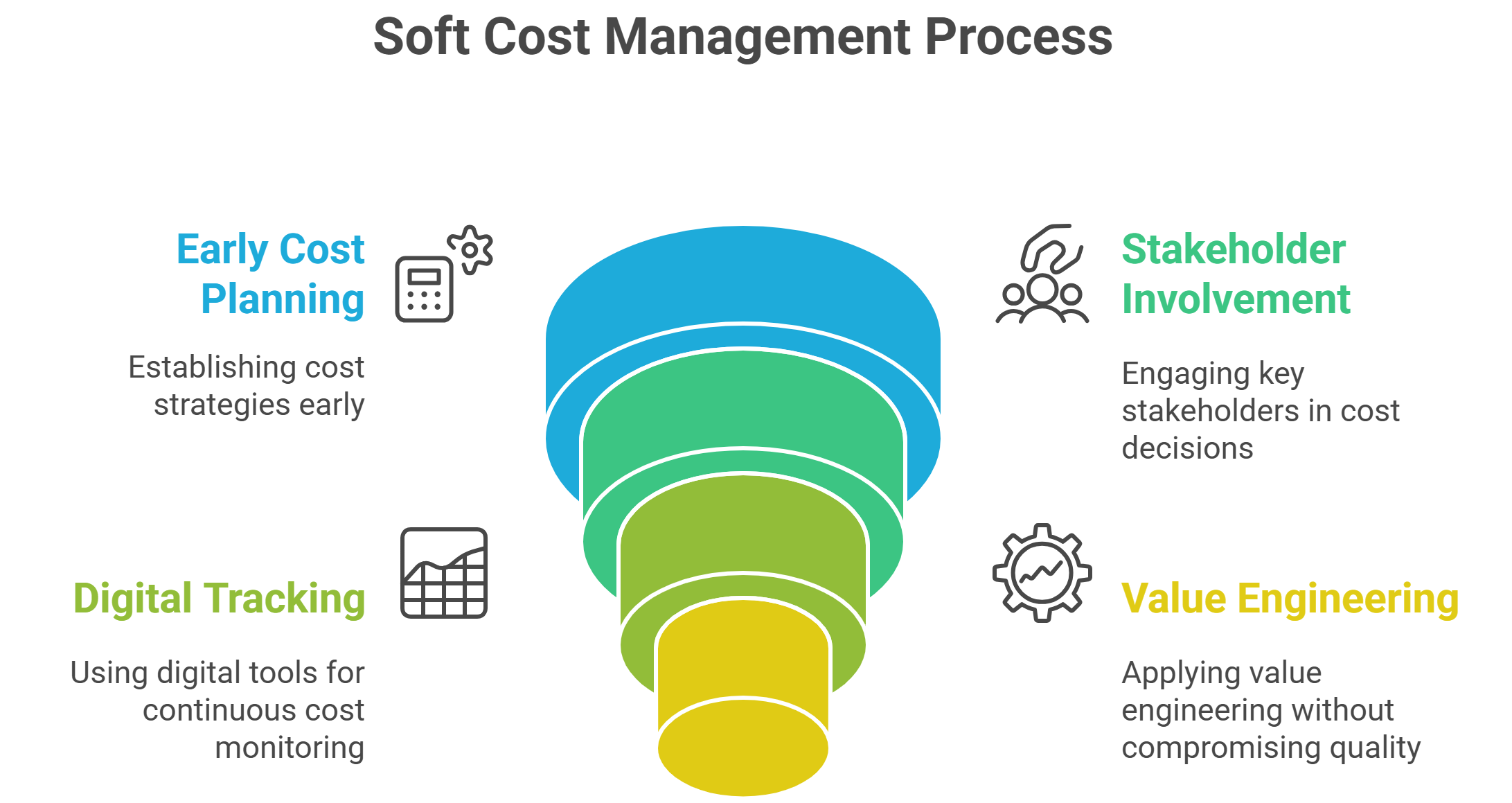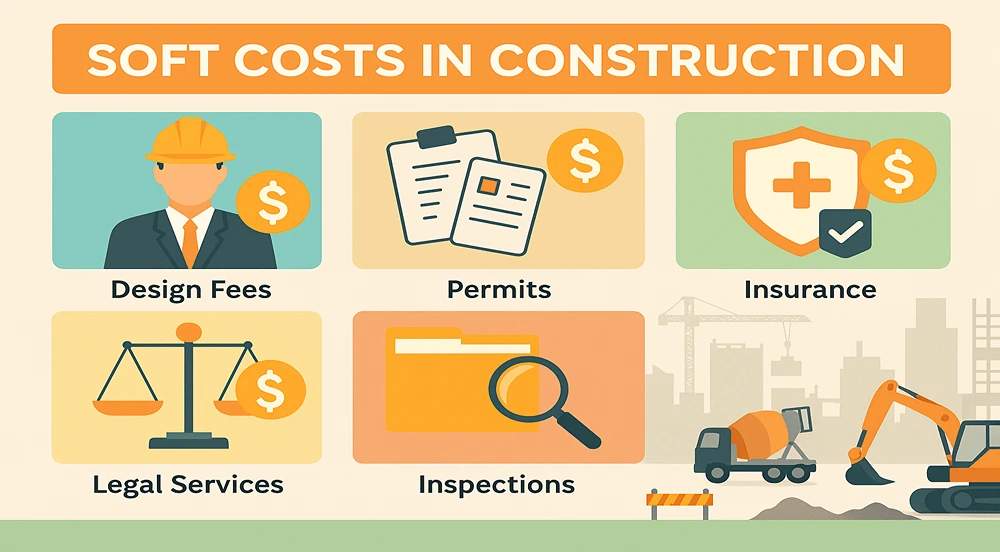Design fees, permits, insurance, and project management costs greatly affect estimation accuracy. Construction project soft costs often account for a quarter of total expenses, influencing budgeting and cash flow. Neglecting these non-tangible items during estimating leads to unrealistic bids and project cost overruns.
What Do Soft Costs Really Mean in Construction?
Picture this: you’ve nailed down the bricks and mortar, but the real challenge lies in the fees that keep everything moving behind the scenes. Construction project soft costs encompass all those essential outlays not tied directly to physical building work, like permits and insurance, which often surprise newcomers to the industry.
These costs, while intangible, form a critical backbone for any venture. For instance, in a mid-sized residential development in Sydney, overlooking a single construction soft cost such as legal consultations could add thousands unexpectedly. Drawing from years in Australian construction, I’ve seen how these elements, when managed well, turn potential pitfalls into streamlined operations.
The Main Types of Soft Costs You Need to Know
Diving straight into the essentials, architectural and engineering fees top the list as they shape your project’s blueprint from day one. These design-related construction project soft costs ensure compliance and innovation, but they demand careful allocation to avoid budget creep.
Next up are financing charges, including interest on loans and banking fees, which can fluctuate with market rates. Legal and administrative expenses follow, covering contracts and approvals. Finally, operational items like marketing and temporary utilities round out the picture. In one Melbourne high-rise I consulted on, these categories highlighted how a balanced approach prevents overruns.
To clarify, here’s a quick breakdown:
- Design Fees; Architectural plans and engineering assessments.
- Financing Expenses; Loan interest and origination fees.
- Legal Costs; Permits, contracts, and compliance audits.
- Operational Outlays; Insurance, marketing, and site management.
Why Accurate Estimation of Soft Costs Determines Profitability?
Imagine forecasting your project’s endgame only to find hidden fees derailing your returns; that’s the harsh reality without precise planning. Accurate estimation of construction project soft costs directly influences your bottom line by revealing potential savings and risks upfront.
Industry data shows that these costs typically represent 20-30% of total budgets, with variations based on project scale. For example, in a commercial build in Brisbane, underestimating the construction soft costs percentage led to a 15% profit dip. By integrating reliable project cost resources into your initial assessments, you can mitigate such issues and boost overall viability.Hard Costs vs. Soft Costs In Construction & Real Estate Development
Best Practices to Manage and Control Soft Costs
Stepping up your game starts with recognising that proactive steps can trim unnecessary expenses without cutting corners. In my experience across offshore Australian projects, embedding these practices from the outset transforms chaotic budgets into controlled successes.

Focusing on collaboration and foresight, these methods ensure every dollar counts. Now, let’s explore specific tactics that have proven effective in real-world scenarios.
Start Cost Planning Early in the Design Phase
Kicking off with a solid foundation means integrating cost considerations right when ideas take shape. Early planning for construction project soft costs allows you to spot inefficiencies before they balloon, saving time and resources down the line.
In a coastal development project, initiating reviews during schematic design reduced the construction soft costs percentage by 12%. This approach, rooted in thorough analysis, ensures designs align with financial realities from the get-go.
Involve Key Stakeholders in Cost Decisions
Bringing everyone to the table early fosters transparency and smarter choices. Involving stakeholders in discussions about construction project soft costs uncovers insights that solo planning might miss, leading to more robust outcomes.
For instance, on a Perth infrastructure job, regular input from owners and subcontractors adjusted the construction soft cost allocations, averting a potential 10% overrun. This inclusive method builds trust and refines strategies effectively.
Use Digital Tools for Continuous Cost Tracking
Harnessing tech keeps your finger on the pulse of spending patterns. Digital tools streamline monitoring of construction project soft costs, providing real-time data that highlights deviations instantly.
One warehouse build in Adelaide utilised software to track expenses, cutting discrepancies by 18%. Such precision not only enhances accuracy but also empowers quick adjustments.
Apply Value Engineering Without Compromising Quality
Refining designs to maximise value means evaluating alternatives that deliver the same results at lower costs. Applying value engineering to construction project soft costs involves scrutinising options like material swaps or process tweaks.
In a recent Sydney retrofit, this technique shaved 8% off the construction soft costs percentage while maintaining standards. It’s about intelligent trade-offs that preserve integrity.
Planning and Budgeting Strategies That Keep Soft Costs in Check
Crafting a roadmap that anticipates twists ensures your finances stay on track. Effective strategies for handling construction project soft costs blend foresight with flexibility, drawing on proven frameworks to guide decisions.
Consider this table for a clear view of key strategies and their impacts:
| Strategy | Description | Potential Savings |
|---|---|---|
| Contingency Allocation | Set aside 5-10% for unforeseen items | Up to 15% reduction in overruns |
| Phased Budgeting | Break down costs by project stages | Improved accuracy by 20% |
| Benchmarking | Compare against industry averages | Identifies 10-25% inefficiencies |
Leverage Technology to Improve Cost Tracking Accuracy
Embracing modern solutions turns guesswork into precision. Leveraging technology for construction project soft costs enhances visibility, allowing you to pinpoint variances before they escalate.
Tools like cloud-based platforms integrate data seamlessly, as seen in a Darwin expansion where real-time tracking via apps reduced errors by 22%. This not only sharpens forecasts but also supports informed pivots. Incorporating Construction Cost Forecasting early in the process further refines predictions, ensuring your projections hold up under scrutiny.
The Role of Contracts and Scope Clarity in Soft Cost Control
Clear agreements act as your safeguard against creeping expenses. Well-defined contracts play a pivotal role in controlling construction project soft costs by outlining responsibilities and limits explicitly.
Scope clarity prevents misunderstandings that inflate costs, like in a Canberra office build where precise terms avoided a $50,000 legal tangle. This foundation ensures all parties align, minimising disputes.
Final Take: Navigating Soft Costs for Smarter Project Decisions
Wrapping up, mastering these elements equips you to make choices that drive success. Navigating construction project soft costs demands a blend of vigilance and strategy, ultimately leading to more predictable and profitable endeavours.
Reflecting on countless projects, the key lies in treating each construction soft cost as an opportunity for optimisation. With the right mindset, you’ll turn potential challenges into strengths that set your work apart.


